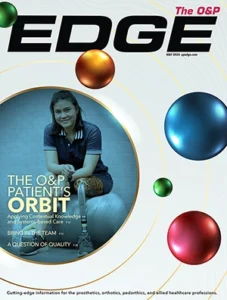Hey O & P ListServ Community!
Thank you so much for all of your participation in my O & P Clinician Population Survey. I wanted to report to you some of the results.
This was my most popular survey with 396 respondents with a 100% completion rate with an average survey time of 3m:47s from 1/8/2020 to 2/15/2020. As with most of my previous surveys the survey may have been skewed to those with more experience. A majority of the respondents, 35%, had 26 or more years of experience, but clinician’s with 10 or less years of experience were 25%.
With respect to the certification level 62% were CPO’s, 18% were CP’s, and 14% were CO’s which may be changing as more practitioners are crossed trained. Most practitioners, 25% were from Regional Mult-Center, Privately owned offices, 23% were from Single Office, Private owned. Only 12% were from Cross-Regional, Multi-center, Corporate owned office which may have shown an under-representation.
The number of patients seen per day showed that 25% saw 5-6 patients per day, and 25% saw 7-8 patients per day. In short 75% of respondents shaw 8 or fewer patients per day.
With respect to the statements a score of 3 means it was neutral, above 3 was slight agreement, below 3 is slight disagreement. There was a strong central tendency meaning the answer Neutral did predominate. I could have forced agreement or disagreement, but that is really not a fair statistical measure of responses.
The number of practitioners has not grown to meet the approximate 35% projected increase, so clinicians may be seeing approximately 35% more patients today than in 2002. Score 2.85, Slight disagreement
The number of practitioners has increased and currently addresses the demand of the market adequately. Score 3.06 Neutral
This projection indicated that there should be more schools in O & P and now there may be too many producing too many graduates. Score 2.94, Neutral
The increased patient need is being met by a team of clinical and technical assistants led by O & P clinicians. Score 3.16, Slight Agreement
Experienced, single-disciplined practitioners may not be as attractive to employ as MS, dual-disciplined practitioners due to the combined need of orthotics and prosthetics. Score 3.46, Agreement
A greater number of practitioners and schools are still needed to serve the O & P Market in the future. Score 3.02, Neutral
Other allied health professions are encroaching on O & P services to fill the current need. Score 3.79, Agreement (Strongest agreement)
There were 141 comments and I looked looked for comments that the current population of clinicians is adequate and if the current clinicians feel. The predominant opinion of 41 comments was there is a changing role of the practitioner driven by the economics and profitably with consolidation to see more patients and spend less time with them so they can get authorizations.
Comments from 42 respondents feel that there did not seem to be a shortage of practitioners although the volume of patients seems to have increased. Respondents differed a bit as to the reasons. Some thought this was the proper use of ancillary clinical and technical support, greater personal patient load, patient ambivalence for fitting, or professional encroachment by physician groups or other allied health professionals. Some commented that this increased volume of patients has driven more “absolutist thinking†or one-track for fitting as well as de-emphasis of knowledge of a variety fitting options. Secondarily this de-emphasize the role of the experienced practitioner and or the need for transfer of clinical concepts to younger practitioners.
Some of the comments in this category indicated that more high-quality residencies are needed rather than more O & P schools. This was also found where 22 respondents questioned the ability of new students in terms of their basic clinical and material skills which may help them to be more employable in smaller offices.There is also the feeling that the economic needs of masters degree students are not being supported when considering their student debt, which may affect a degree of attrition before and during residencies. There were 12 comments the use of clinical assistants and ability with research to exend the clinical role. However 11 noted serious concerns about professional encroachment and protection of licensure laws to answer that increased clinical volume.
As I move forward I will be looking at the differences between those with less or greater than 10 years experience, certification level, volume of patients seen, and the office context. Let me know if you have other ideas too.
Thanks again!
Gerry
Gerald Stark, Ph.D, MSEM, CPO/L, FAAOP(D)
Senior Prosthetic-Orthotic Specialist
Adjunct Professor
College of Engineering & Computer Science
University of Tennessee at Chattanooga
[email protected]
[email protected]
Gerald Stark, Ph.D, MSEM, CPO/L, FAAOP(D)
Senior Prosthetic-Orthotic Specialist
Adjunct Professor
College of Engineering & Computer Science
University of Tennessee at Chattanooga
[email protected]
[email protected]




